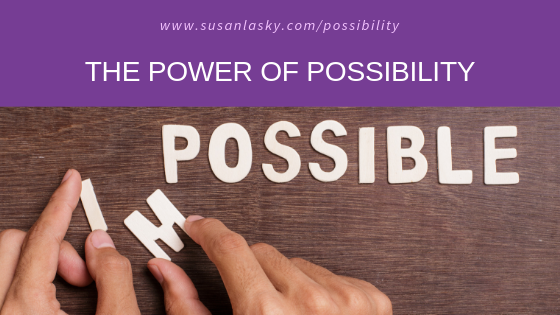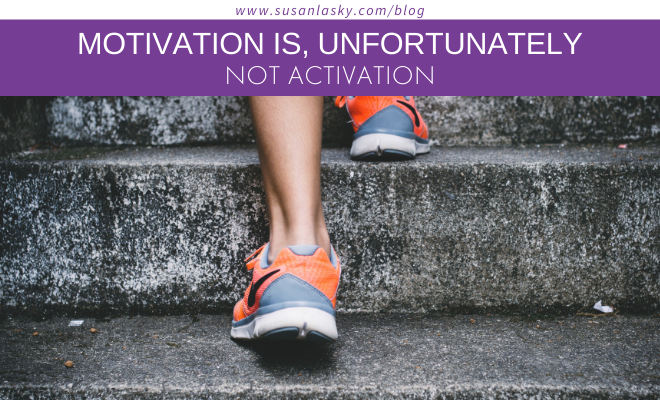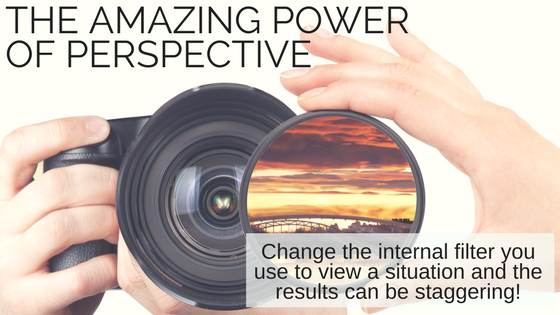
by Susan Lasky | Dec 3, 2018 | Attitude, Perspective, Problem-Solving, Self-coaching
Sometimes it is more difficult to believe in the power of possibility than at other times. So, when we have reminders, hold onto them!
What am I talking about? In my 7-Step PowerPlan to Success™ (you can download the free ebook here), the first Step is Self-Awareness – knowing who you are, and aren’t… what you’re likely to do, and what you probably won’t… what you like, and what you don’t. It’s about accepting your reality, and so Step #2 is Self-Acceptance. This isn’t about giving in or giving up, but about starting from where you are, not where you (or others) wish you were. New studies are showing that Self-Acceptance is fundamental to both happiness and, perhaps surprisingly, productivity. Making better choices that suit you, and planning realistically, helps minimize overwhelm, which then makes it easier to get things done.
Knowing… and accepting… yourself doesn’t mean you can’t change or improve. That’s why Step #3 is Belief in Possibility – that you always have a choice in the matter. You can’t always control a situation, but how you choose to react can change your life (and often the lives of others, as have those people who began movements or charities after being affected by negative events in their personal lives).
But I’m writing this to talk about the inner power we have that is sooo easy to overlook. Sometimes we’re reminded, and that helps. Today I had an old post of mine pop up on Facebook. It was about an event that happened three years ago, and I’m thankful for the reminder that I have the inner power to do things that I may not intellectually or emotionally believe possible.
I was at an energy workshop. The presenter was Dr. Gene Ang, a Yale-trained neurobiologist. He spoke about the power we have to heal, ourselves and others. To prove that our minds (and spirit) can do things that science would scoff at, we were all given heavy-weight metal utensils (forks and spoons). He walked us through an exercise that ended with being able to bend these thick and solid utensils with thought and energy, not strength. Of course we tried to bend them in every way (including using double fisted grip strength) before the exercise, with no success (ok, no WWE members in the group).

Then we did the energy exercise, and those spoons started bending – I mean really bending. It wasn’t our physical strength that did it, but our focus and will, channeling stronger forces as we loosely held these store-bought utensils by their handles. I admit – I was totally frustrated, being one of the last non-benders in the room. I let out a healthy expletive, directed towards my recalcitrant spoon, and let go of trying. The spoon immediately ‘softened’ in my hand and bent totally in half (see the picture – it’s a cell photo of my handiwork). Wow!
So when you’re running low on positive possibility, remember the spoons – change is within you! Apparently, the Universe wants us to succeed, when we’re really clear about what we want, and willing to put in targeted effort.
I especially like this spoon story at this time of year, bringing the focus from shopping and stress back to miracles and possibility.
Wishing you a wonderful Holiday Season!

by Susan Lasky | Dec 14, 2017 | ADD - ADHD, Attitude, Perspective, Productivity, Relationships, Self-Care, Self-coaching
Tips to Conquer Holiday Anxiety Disorder

Magical holidays? Not for everyone. We’re supposed to feel festive… energetic… excited! We’re supposed to look forward to the New Year with anticipation and, well, happiness – it is ‘Happy New Year,’ right? So, why does this time of year create so much stress and anxiety? Why are so many people exhausted, even depressed under their cheery façades?
Since the first step in working through a problem is to recognize, define and accept it, let’s face it – the holiday season CAN be fun, but it can also be incredibly challenging. Especially this year, with the intense political discord and the many natural disasters. So give yourself a break!
Sure, there are tons of positive things about the holidays, including the window displays, the festivity, the spirituality and the family bonding. But there are also tons of stressors, like the time and effort of preparing for family gatherings, parties, travel arrangements, shopping, the additional expenses, rush to complete work projects, etc.
First it’s the Thanksgiving gathering (if you have people with whom you gather, and if you don’t, you might feel a sense of isolation). Having people over, for the somewhat disorganized, can be a time-consuming quagmire. It isn’t just the meal prep; it’s clearing the paper clutter off the dining table and finding hiding spots for the various piles of stuff. And the traveling doesn’t help – especially if stuck in holiday traffic (I admit it; I’ve skipped family events to avoid a two-hour traffic jam).
Thanksgiving Day immediately segues into the holiday buying frenzy, with its extra expenses and the stress of gift-buying, magnified by the pressure of getting those perfect bargains during Black Friday and Cyber Monday (now week-long, or longer, events). This is further complicated by the anxiety caused by FOMO – fear of missing out, whether it’s the sale of the century or that special party invite. Who has invited you where (and who hasn’t)? How should you reciprocate? What should you wear? And woe if you’ve gained or lost weight and don’t feel attractive in the holiday clothes you have! Even the lack of sunlight can darken the mood of people with a degree of SAD (seasonal affective disorder).

Then there are the interpersonal issues. Whether it’s home for the holidays and dealing with complicated family relationships, or the feelings of loss when you think about missing loved ones or the lack of a significant other with whom to share a New Year’s kiss. There is also the double-edged pleasure of having children home from school, especially if you still have to work. And magnify the difficulty if you have children who get easily overwhelmed or overly excited by a disruption of their routine.
On a more subtle note, there’s a sense of judgement. The year is about to end, and what have you accomplished? Sometimes it’s external evaluations at work, which may, or may not, include raises and bonuses. But often it’s an internal sense of “I planned to do more…“. Unfortunately, we tend to dwell more on what we didn’t do than celebrate everything we did accomplish. Like a birthday, the upcoming New Year is a passage, and an opportunity (welcome or not) to pause and look at where we are in life.
I can go on, but now that it’s really clear you have valid reasons to feel Holiday Anxiety Disorder, let’s switch to what we can do differently to have a better, more fulfilling holiday season.
Let Go of the ‘Shoulds’
Many of us dwell in a mental world of how things should be. Relationships are warm, fuzzy and supportive. Money is not a concern. We’re easily able to leap tall buildings, which represents any obstacle, whether preparing a holiday meal or completing a work project early and under budget. Our children are always a joy, and our parents are never a problem. Realistically, we know that’s ridiculous. But there’s a part of us that wants it to be that way, and thinks it should be that way. Until we embrace imperfection and still delight in ourselves and others – despite our failings, and theirs – we’re doomed to feel like failures.
Practice Intentional Rejuvenation
Schedule in ‘ME’ time. Consider it as My Energy; time to recharge. It might mean a massage, distraction-free time to read, draw, play the guitar or go for a walk – whatever recharges your sense of self, so you’ll have more to give to others. If you spend too much time alone, working or taking care of your family, plan get-togethers with friends. Let go of the guilt that comes from having too little time to get things done or take care of others, so you give even less to yourself. As the airlines say, ‘put the oxygen mask on yourself before you worry about others.’ Keep in mind that self-care is not the same as ME time. Things like going to the gym are important for self-care, but there aren’t ME time, unless you love going to the gym!
Put Your Health First
Alas, that includes getting enough sleep, eating right, staying hydrated and exercising. These are all critical for real self-care. They take effort, but the payoff is that you’ll have more energy, and feel a lot less stressed. And for those of us with ADHD, depression or anxiety, these have proven, brain-based benefits. Studies show that spending some time in nature, even in winter, helps positivity. Get outside, even if it’s cold. Use natural daylight bulbs. And consider appropriate supplements, like Vitamin D and Omega-3.
Give Yourself Permission
It’s okay to decline an invitation. It’s okay to serve fewer choices at a meal or have less elaborate holiday decorations. And it’s okay to ask for help.
Set Limits
This might be the dollar amount or the number of gifts you’ll purchase. It might mean how much time you’ll spend shopping (maybe the online purchase isn’t as perfect as something you’d pick out in a store, but it’s a lot easier!). Also, consider how you can say no to unacceptable behavior, whether from a child, friend or family member. This also applies to work. Learn to say NO to yourself! Perfectionism destroys productivity. Be realistic in terms of what you can accomplish in a given time, and what you can’t. Have clear priorities and learn to self-advocate.
Journal
Write down your frustrations – it’s better than taking them out on others, or yourself. Keep a gratitude journal to remind yourself of what you have, and what you’ve done. Keep a list of what you can do differently next year, and a reminder of what you’ve done that works. (Don’t count on remembering anything, although do try to remember where you keep your Journal and lists!)
Pause – Breathe – Appreciate
Life is a collection of moments, so capture those moments by being truly present. Mindfulness is a way of staying centered, and when we’re centered in the moment we can’t be disappointed by the past or anxious about the future.
Expect Breakdowns
It’s extremely rare when everything works as planned. Stuff happens. Being flexible and building in the expectation that there will be occasional breakdowns and meltdowns makes it easier to deal with them when they (inevitably) happen, and increases the likelihood that your holidays will be successful!
Focus on the Positive
In my 7-Step PowerPlan to Success™, Step 3 is ‘Believe in Possibility, and that you always have the Power of Choice.’ When you truly believe that you will have a wonderful, fulfilling holiday season, and that the upcoming year will be your best one yet, you dramatically increase the likelihood it will be. Positive thinking is critical to successful action. How we think absolutely affects what we attract in our lives.
Plan for Success
A positive attitude is essential, but achieving goals is more likely when there’s also a plan in place. It’s helpful to have clarity as to goals and priorities, and the steps you’ll take to reach them, whether it’s planning for December 25th, New Year’s Eve or the upcoming year. If you need help with your Success Plan, let me know!
Have the Happiest of Holidays!!!
What are your tips to conquer Holiday Anxiety Disorder? I’d love to see them, so share them on my blog.
This article may be reposted, only with the following attribution:
Written by Susan Lasky, Productivity, ADD/ADHD, Executive Function & Organization Coach. Susan Lasky Productivity Solutions, www.SusanLasky.com. Used with permission.

by Susan Lasky | Sep 15, 2017 | ADD - ADHD, Attitude, EF - Executive Function, Perspective, Problem-Solving, Procrastination, Productivity, Project Management, Self-coaching, Time Management, Uncategorized, Work from Home

There is often a collapse in our understanding when it comes to getting things done. We’re taught to believe that if we were really motivated, we would get started on that work project, organize the closet or declutter the entry. We’re told that if we really cared about our family’s health, we would consistently prepare tasty, nutritious meals. We tell ourselves that if we’re not exercising or finishing the online course we started, lack of willpower and poor self-image is to blame. If only we tried harder… Maybe, but not likely.
Activation, unlike motivation, is an executive function skill, also known as Initiation. That means it is brain-based in an area of our brain (the frontal lobes) that may not be as consistently high-performing as we’d like. Especially so for people with ADD / ADHD. This is the area of our brain that is largely responsible for things like organization, time management, prioritization and activation (the ability to get started on something). It is easily overwhelmed by too much to do, confusion as to how to do things, or the dread that comes when a project seems too big or boring to be easily accomplished.
That’s when the protective amygdala— the part of our brain that helps us to manage stress— steps in with its fight, flight or freeze response. So we go into avoidance mode. OK, this is an oversimplification, but it helps us to understand WHY we find that doing some things becomes so challenging that we continually procrastinate, even if we are motivated to get them done.
Just because we’ve decided to do something, doesn’t mean we will actually get it done – despite motivation by desire, rewards or dire consequences. This lack of ability to get going can be both frustrating and scary!Here are eight strategies to help you overcome overwhelm, minimize the avoidance factor, get activated and successfully accomplish your goals.
 Stop Identifying Yourself by Failure. Procrastinator. Lack of willpower. Lazy. Unmotivated. Selfish. Inconsiderate. Untrustworthy. These are words that make me want to quit, not put in the effort needed to overcome a brain-based executive function challenge. So recognize that despite the widespread ‘Just do it’ mentality, it’s often necessary to find work-arounds. Let go of the negative self-talk. Accept that you’re having difficulty beginning a task, and instead of being self-critical and judgmental (which accomplishes nothing), be gentle with yourself. You may be anxious about the task, uncertain about how to get it done, uncomfortable about doing it (like calling a company to complain about something), or stuck because you might ‘do it wrong.’ Avoid paralysis by analysis. Often all that’s needed is that first step, which is what activation is about. Identifying what is getting in the way is part of the solution. It’s important to take action despite your feelings, but it helps to understand them. Studies show that you’re 50% more effective if you first get clarity as to why it’s tough to get going, than you’d be if you just push through and try to get it done.
Stop Identifying Yourself by Failure. Procrastinator. Lack of willpower. Lazy. Unmotivated. Selfish. Inconsiderate. Untrustworthy. These are words that make me want to quit, not put in the effort needed to overcome a brain-based executive function challenge. So recognize that despite the widespread ‘Just do it’ mentality, it’s often necessary to find work-arounds. Let go of the negative self-talk. Accept that you’re having difficulty beginning a task, and instead of being self-critical and judgmental (which accomplishes nothing), be gentle with yourself. You may be anxious about the task, uncertain about how to get it done, uncomfortable about doing it (like calling a company to complain about something), or stuck because you might ‘do it wrong.’ Avoid paralysis by analysis. Often all that’s needed is that first step, which is what activation is about. Identifying what is getting in the way is part of the solution. It’s important to take action despite your feelings, but it helps to understand them. Studies show that you’re 50% more effective if you first get clarity as to why it’s tough to get going, than you’d be if you just push through and try to get it done.
 Set Aside Planning Time and Action Time. They are not the same. Planning time is for deciding exactly WHAT you are going to do, and HOW you’ll get it done. It’s the time to determine your priorities and decide WHEN you’ll actually work on your tasks (your Action times). It’s the time to make DECISIONS, so they don’t hold up your progress once you start working. Sometimes we plan to do something without being realistic about how much available time we actually have (the ‘white space’ in our calendars). So when planning, take all of your time commitments into account. And don’t overplan. Activation takes effort, so leave space for recharging, along with time to deal with interruptions, unexpected tasks or spill-overs from tasks that take longer than planned. If you skip Planning time and go directly to Action time, it’s easy to lose focus on what is most important and spend that Action time pursuing any new bright and shiny object (or checking emails, Facebook, Instagram, Twitter, Pinterest, etc.). If you haven’t planned very specific tasks for your Action time, it’s easy to get overwhelmed by all of the options when you are ready to work.
Set Aside Planning Time and Action Time. They are not the same. Planning time is for deciding exactly WHAT you are going to do, and HOW you’ll get it done. It’s the time to determine your priorities and decide WHEN you’ll actually work on your tasks (your Action times). It’s the time to make DECISIONS, so they don’t hold up your progress once you start working. Sometimes we plan to do something without being realistic about how much available time we actually have (the ‘white space’ in our calendars). So when planning, take all of your time commitments into account. And don’t overplan. Activation takes effort, so leave space for recharging, along with time to deal with interruptions, unexpected tasks or spill-overs from tasks that take longer than planned. If you skip Planning time and go directly to Action time, it’s easy to lose focus on what is most important and spend that Action time pursuing any new bright and shiny object (or checking emails, Facebook, Instagram, Twitter, Pinterest, etc.). If you haven’t planned very specific tasks for your Action time, it’s easy to get overwhelmed by all of the options when you are ready to work.
 Use your Planning time to gain CLARITY. What are the specific tasks that will enable you to make progress towards your goal? A project is too big to ‘do’ in one sitting, so the thought of ‘doing’ an entire project is overwhelming, resulting in avoidance rather than clarity. It’s easier to activate when there’s something very specific to do, with no conflicting priorities and a set time for starting –and ending– your efforts. It’s the way you solve that proverbial question, “How do you eat an elephant?” (the project you tend to avoid because it’s just too big, scary or unappetizing). How? One bite at a time! Begin by breaking the project into do-able tasks, or individual bites that aren’t too painful to swallow. The smaller you make them, the easier they’ll fit into your busy schedule. Prioritize those tasks (what has to be done before you can move on to the next task?). WRITE DOWN THE STEPS! Then, when you are in Action time, put on your blinders to stay focused on the designated task.
Use your Planning time to gain CLARITY. What are the specific tasks that will enable you to make progress towards your goal? A project is too big to ‘do’ in one sitting, so the thought of ‘doing’ an entire project is overwhelming, resulting in avoidance rather than clarity. It’s easier to activate when there’s something very specific to do, with no conflicting priorities and a set time for starting –and ending– your efforts. It’s the way you solve that proverbial question, “How do you eat an elephant?” (the project you tend to avoid because it’s just too big, scary or unappetizing). How? One bite at a time! Begin by breaking the project into do-able tasks, or individual bites that aren’t too painful to swallow. The smaller you make them, the easier they’ll fit into your busy schedule. Prioritize those tasks (what has to be done before you can move on to the next task?). WRITE DOWN THE STEPS! Then, when you are in Action time, put on your blinders to stay focused on the designated task.
 Make the Task more Appealing. How can you turn a need-to, should-do or must-do into a want-to? Same task, different attitude. Even then activation may be difficult, but it’s easier when you see a positive reason for accomplishing a task (even if it’s just to get it over with so it no longer gives you angst!). How can you add a fun element to the task? Some ideas: Do it with a friend, working together or just in parallel play… get out of your home or office and work in a coffee shop or park… upgrade your writing tools with a special pen and appealing notebook… promise yourself a reward for getting the task accomplished (even if it’s just some guilt-free ‘me’ time)… make finishing the task a game… have a giant check-off list, etc. Or try one of my favorites: get to work on it to avoid doing a task that’s even less appealing! Remember the benefit. Write down what you will gain from finishing the task. Keeping the goal in mind can make the work that goes into accomplishing it less onerous.
Make the Task more Appealing. How can you turn a need-to, should-do or must-do into a want-to? Same task, different attitude. Even then activation may be difficult, but it’s easier when you see a positive reason for accomplishing a task (even if it’s just to get it over with so it no longer gives you angst!). How can you add a fun element to the task? Some ideas: Do it with a friend, working together or just in parallel play… get out of your home or office and work in a coffee shop or park… upgrade your writing tools with a special pen and appealing notebook… promise yourself a reward for getting the task accomplished (even if it’s just some guilt-free ‘me’ time)… make finishing the task a game… have a giant check-off list, etc. Or try one of my favorites: get to work on it to avoid doing a task that’s even less appealing! Remember the benefit. Write down what you will gain from finishing the task. Keeping the goal in mind can make the work that goes into accomplishing it less onerous.
 Think Progress, not Perfection. It’s easier to eat the elephant (work on that task or project) when you feel like it, or when you’re really hungry (deadline anyone?). But that’s a less effective way of ensuring you successfully accomplish your business or personal goals than if you were to commit to taking small, palatable bites every day (consistent effort). Prioritize the bites and keep them small, triumphing over your perfectionistic avoidance tendencies. Consistent small bites get things done!
Think Progress, not Perfection. It’s easier to eat the elephant (work on that task or project) when you feel like it, or when you’re really hungry (deadline anyone?). But that’s a less effective way of ensuring you successfully accomplish your business or personal goals than if you were to commit to taking small, palatable bites every day (consistent effort). Prioritize the bites and keep them small, triumphing over your perfectionistic avoidance tendencies. Consistent small bites get things done!
 Take a Short Detour to Gain Momentum. Sitting and staring at a blank screen won’t get that blog written. First, try doing a tiny action, like writing one sentence. This small action will often get you over the inertia hump, so you can continue. But if you find yourself unable to initiate action, take a detour. Do something physical (energizes your body and your mind). Take a short nature break (relaxes the anxiety and provides a feeling of well-being you can take back to your desk). Call a positive friend and make plans to do something fun. Listen to music that energizes and helps you stay focused. Make sure you eat and drink (dehydration contributes to brain fog). If you take medication, check that you’ve taken it. If you need ten minutes of down time, take it – even if it’s to check your social media or email (be safe and set a STOP alarm!). Remind yourself of your commitment to get to your Action task, and then, refreshed, get back to work.
Take a Short Detour to Gain Momentum. Sitting and staring at a blank screen won’t get that blog written. First, try doing a tiny action, like writing one sentence. This small action will often get you over the inertia hump, so you can continue. But if you find yourself unable to initiate action, take a detour. Do something physical (energizes your body and your mind). Take a short nature break (relaxes the anxiety and provides a feeling of well-being you can take back to your desk). Call a positive friend and make plans to do something fun. Listen to music that energizes and helps you stay focused. Make sure you eat and drink (dehydration contributes to brain fog). If you take medication, check that you’ve taken it. If you need ten minutes of down time, take it – even if it’s to check your social media or email (be safe and set a STOP alarm!). Remind yourself of your commitment to get to your Action task, and then, refreshed, get back to work.
 Be Aware of Transition Trauma. Sometimes it’s hard to stop one activity to begin another. Our brains just don’t want to make the switch. Be clear as to what you plan to do when. Write it on your Daily Action List. Put it in your calendar as a Task-Appointment. Use alarms to define your Action times and alert you that it’s time to begin (activate). Get up and move between activities so you can clear the Zombie-like focus, or hyperfocus, from a previous task (or from that computer solitaire marathon session).
Be Aware of Transition Trauma. Sometimes it’s hard to stop one activity to begin another. Our brains just don’t want to make the switch. Be clear as to what you plan to do when. Write it on your Daily Action List. Put it in your calendar as a Task-Appointment. Use alarms to define your Action times and alert you that it’s time to begin (activate). Get up and move between activities so you can clear the Zombie-like focus, or hyperfocus, from a previous task (or from that computer solitaire marathon session).
 Find an Accountability Partner. When someone else cares whether we’ve accomplished what we said we would, we’re more likely to get it done. This is often difficult when you work alone. Just as it’s easier to get to the gym when you go with a friend, it’s easier to get activated and work towards your goals when there are others who are supportive of your efforts and cheerleaders for overcoming your challenges. Share with a non-judgmental friend, join a mastermind group, consider the benefits of individual coaching, or join a group like my TUIT Project, which is designed to provide support and accountability. A new online group begins each month—visit OvercomeOverwhelm.com.
Find an Accountability Partner. When someone else cares whether we’ve accomplished what we said we would, we’re more likely to get it done. This is often difficult when you work alone. Just as it’s easier to get to the gym when you go with a friend, it’s easier to get activated and work towards your goals when there are others who are supportive of your efforts and cheerleaders for overcoming your challenges. Share with a non-judgmental friend, join a mastermind group, consider the benefits of individual coaching, or join a group like my TUIT Project, which is designed to provide support and accountability. A new online group begins each month—visit OvercomeOverwhelm.com.
Also consider the benefits of individual coaching. Contact Susan Lasky Productivity Solutions to discuss how coaching could help you move forward and have a less stressful, more fulfilling life. Susan is based in Westchester, but works virtually anywhere. She can be reached at 914-373-4787 or Susan@SusanLasky.com. You can schedule a convenient, no-cost or obligation Initial Consult at https://SusanLasky.AcuityScheduling.com.

by Susan Lasky | Jan 26, 2017 | ADD - ADHD, Attitude, Perspective
Change the internal filter you use to view a situation and the results can be staggering!
Words are powerful – whether you say them out loud or just think them. They reflect how we perceive a situation, a person or ourselves. They can reinforce the positive, but all too often they give power to the negative. When we change our perception – what we think we see – our dialog changes. These new thoughts, and the accompanying words, can move us forward, instead of keeping us trapped.
When my son was about 9, he was in a crowded restaurant, sitting at a table with several adults. Running about the restaurant and disturbing the patrons was a very young girl. One of the adults described her as hyperactive, and the others agreed. But not my son, who said, She’s not hyperactive, she’s just actively exploring the world. Whoa…
Here’s a little girl who could grow up thinking of herself as having a problem, as being different in a negative way. Or she could grow up believing herself to be a curious explorer, destined to discover new things and truly observe the world around her. Think of her parents, who could either see her as a challenge or see her potential and help her to positively channel her energy.
In coaching we call this process of looking at things from a different perspective ‘reframing’. When you change the frame, the picture looks different.
Take the trait of impulsivity, which is often considered negative (and can sometimes lead to dire situations). However, without it there would be little creativity, which is often the flip side of spontaneity. Impulsivity can be a strength, leading to new ideas, and to taking risks on new businesses and new experiences. How dull life would be without it! Instead of perceiving impulsivity as negative, try looking at it from its potential, and help to positively channel that creativity and willingness to take risks.
When Thomas A Edison was young, he was sent home from school with a note. His mother told him it said, “Your son is a genius.” This school is too small for him and doesn’t have teachers who are good enough to train him. Please teach him yourself. Many years later he found the actual note, which said, “Your son is mentally deficient. We cannot let him attend our school anymore. He is expelled.” He wrote in his diary, “Thomas A Edison was a mentally deficient child whose mother turned him into the genius of the century.”
I don’t know whether that story is true, although I do know he was expelled from school (and that he also blew up part of his home doing experiments, and most likely had ADHD). His mother chose to interpret the school note from a different perspective, and look at the difference that made! She chose words that changed her son’s self-perception. What would his future have been if he thought his teachers considered him ‘deficient’?
So the next time you are tempted to criticize someone – OR YOURSELF! – try to reframe what you are thinking from a positive, supportive perspective. Words can change the future! 🙂
I would love to hear your thoughts on this! – Share your ideas blow.
Looking for help to reframe your perspective? Contact me to discuss coaching by scheduling a no-cost or obligation phone consult or check out my online group at OvercomeOverwhelm.com.
Please feel free to share this article, with the following attribution: Written by Susan Lasky, Productivity, ADD/ADHD, Career & Organization Coach. Susan Lasky Productivity Solutions, www.SusanLasky.com. Used with permission.

by Susan Lasky | Apr 23, 2011 | Attitude
I’ve always believed in the concept of following your passion – in life, in work, in love…
Easier said than done. It helps to know what you feel passionate about, and I find that, although I enjoy and appreciate so many things, I am not always totally clear about what really ‘turns me on.’ Sometimes passion exists only in a brief moment, or it takes a hiatus, or slips into the back seat while economic necessity or logistics drive my life.
(I am aware of those who believe you can always live from passion, and also those who believe you can do anything with passion and commitment, but while both views have merit, they are, for me, sometimes philosophical exercises, instead of my daily reality.)
When I am living my passion there is a sense of aliveness, of deeper purpose at a higher, more meaningful level. I may not even realize I’ve been ‘out‘ of passion until some experience reminds me what it feels like to be ‘in’ it.
The feeling is incredible. I see the difference in my work. Sometimes I’ll be helping a client, and I know I’m doing what needs to be done, but I don’t feel that sense of communion with my higher purpose. It is just a job.
Then there are times when there is magic in a session. My words flow effortlessly and communicate the right information at the right time, in a way that the client is able to really ‘get’ what we discuss. We both feel energized, and I know I have truly touched their life, helping them to see things from a different perspective; opening up the realm of possibility – for both of us.
I ask myself why I don’t always have that sense of fulfillment, and part of the answer is that I am not always doing the type of work that is my passion. So I must do what I coach clients to do – discover what they (I) really want, by creating awareness as to what it is that generates those feelings of excitement, aliveness, meaning and purpose. Once identified, the next step is to create an action plan that will maximize the opportunities for passion in their (my) life.
The goal is to look at what is working for you, and what isn’t, then to decide what you can do to open your life to the magic that happens when living with passion. (Note: Passion doesn’t have to be exhausting, it can be the quiet passion of spending time doing what you value; what brings you joy.)
I’ve done this exercise many times (although not always with awareness and intent), and I will repeat it throughout my life. Kind of a reality check as to where I am on the path of self-fulfillment. Sometimes the action plan is huge – change a job, get married, raise a child, divorce, move, go back to school. Sometimes it is simpler – set aside time each week for doing something you love or take a dream destination vacation.
I want to live my life with passion and joy, and I choose to do whatever I can to make that happen.

















